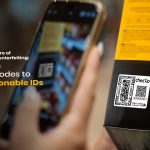Introduction
In discussions around anti-counterfeiting technologies, three terms are frequently used interchangeably—authentication, traceability, and identification. While they sound similar, they represent fundamentally different problem statements and require very different technical solutions. Treating them as the same has resulted in flawed regulations, misplaced investments, and weak brand protection strategies. This blog provides a rigorous breakdown of these concepts and explains why separating them is essential for building secure systems.
1. Authentication: Proving Genuineness
Authentication is the process of verifying whether a product is genuine or fake. It is essentially a verification problem, where the outcome is a simple yes/no decision.
Key requirements for authentication:
- A physically unclonable identifier – one that cannot be replicated even by the original manufacturer (for example, a naturally formed random 3D micro-pattern).
- Seamless and reliable authentication by anyone, anywhere, and anytime.
A useful analogy is human biometrics: Fingerprints or iris, along with a biometric device, are a good analogy because fingerprints are unique and cannot be replicated, and the biometric is reliable. Similarly, anti-counterfeiting requires a “fingerprint” for products, such as a random 3D micro pattern and an app-based verification, which is deemed reliable.
2. Traceability: Recording Supply Chain Events
Traceability refers to the ability to track a product’s journey through the supply chain. Unlike authentication, it assumes the product is genuine and focuses only on recording and recalling its history.
Examples of what traceability enables:
- Monitoring inventory and stock-outs.
- Tracking sales across geographies.
- Managing quality control, recalls, and regulatory compliance.
Traceability is usually implemented using barcodes, QR codes, or RFID tags, combined with databases or blockchain systems that store the event history.
However, traceability alone cannot guarantee authenticity. A cloned QR code (any other 2D identifier can be cloned; claims otherwise are mischievous) will produce the same event history, making it impossible to distinguish genuine from fake products.
3. Identification: Searching for Identity
There is yet another term called identification, as different from both authentication and traceability. It is the process of determining who or what an item belongs to by searching in a large database.
For example:
- Authentication: “Does this fingerprint belong to this person?”
- Identification: “Whose fingerprint is this among millions of records?”
Without going into too much detail, the difference can be understood with a simple example:
- In the Aadhaar system, when I present my fingerprint along with my Aadhaar number and ask for validation that I am who I am claiming to be—this is authentication.
- For identification, imagine a fingerprint lifted from a crime scene. Now the task is to search across millions of records to figure out whose fingerprint it is—a far more complex and laborious process.
4. Where Brands Go Wrong
A major failure in industry and policy comes from equating traceability with authentication.
Examples:
- Drug regulators have mandated QR codes on medicine packs, assuming they prevent fakes. In reality, cloned QR codes either directly show or redirect to the same websites, showing the same information as genuine packs.
- Excise tax stamps on alcohol often rely only on QR-based serials, which are trivially copied.
The root issue is that QR codes look “mystical” (machine-readable, not human-readable). When scanned, they return correct information, giving the false impression of authenticity. But information ≠ authentication.
5. Implications for Anti-Counterfeiting
- Consumers need authentication to be sure products are genuine.
- Supply chain managers need traceability for logistics optimization.
- Law enforcement may occasionally need identification for forensic backtracking.
When these functions are confused, counterfeiters exploit the gaps. For instance, cloned identifiers allow retailers to claim “plausible deniability” when caught selling fakes.
6. The Way Forward
The solution lies in layered systems where each function is clearly defined and implemented:
- Authentication → Physically Unclonable Tags + smartphone-based verification.
- Traceability → Event recording on secure systems.
- Identification → Reserved for forensic and investigative needs.
Clear separation prevents counterfeiters from exploiting weak points in the system.
Conclusion
Authentication, traceability, and identification may sound similar, but they solve very different problems. Authentication verifies whether a product is genuine, traceability provides visibility into its journey across the supply chain, and identification helps establish who or what something belongs to in complex scenarios, rarely used for products.
Treating these terms as interchangeable has led to failed regulations and ineffective technologies. Only by clearly distinguishing them and deploying purpose-built solutions can industries move toward true counterfeit protection.


